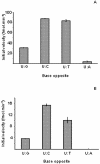Characterisation of the substrate specificity of homogeneous vaccinia virus uracil-DNA glycosylase
- PMID: 12907738
- PMCID: PMC169932
- DOI: 10.1093/nar/gkg672
Characterisation of the substrate specificity of homogeneous vaccinia virus uracil-DNA glycosylase
Abstract
The decision to stop smallpox vaccination and the loss of specific immunity in a large proportion of the population could jeopardise world health due to the possibility of a natural or provoked re-emergence of smallpox. Therefore, it is mandatory to improve the current capability to prevent or treat such infections. The DNA repair protein uracil-DNA glycosylase (UNG) is one of the viral enzymes important for poxvirus pathogenesis. Consequently, the inhibition of UNG could be a rational strategy for the treatment of infections with poxviruses. In order to develop inhibitor assays for UNG, as a first step, we have characterised the recombinant vaccinia virus UNG (vUNG) and compared it with the human nuclear form (hUNG2) and catalytic fragment (hUNG) UNG. In contrast to hUNG2, vUNG is strongly inhibited in the presence of 7.5 mM MgCl(2). We have shown that highly purified vUNG is not inhibited by a specific uracil-DNA glycosylase inhibitor. Interestingly, both viral and human enzymes preferentially excise uracil when it is opposite to cytosine. The present study provides the basis for the design of specific inhibitors for vUNG.
Figures






Similar articles
-
Substrate specificity of homogeneous monkeypox virus uracil-DNA glycosylase.Biochemistry. 2007 Oct 23;46(42):11874-81. doi: 10.1021/bi700726a. Epub 2007 Oct 2. Biochemistry. 2007. PMID: 17910420
-
Mutations at Arginine 276 transform human uracil-DNA glycosylase into a single-stranded DNA-specific uracil-DNA glycosylase.DNA Repair (Amst). 2005 Jul 12;4(7):793-805. doi: 10.1016/j.dnarep.2005.04.019. DNA Repair (Amst). 2005. PMID: 15970468 Free PMC article.
-
Trypanosoma cruzi contains a single detectable uracil-DNA glycosylase and repairs uracil exclusively via short patch base excision repair.J Mol Biol. 2004 Sep 17;342(3):787-99. doi: 10.1016/j.jmb.2004.07.043. J Mol Biol. 2004. PMID: 15342237
-
Poxvirus uracil-DNA glycosylase-An unusual member of the family I uracil-DNA glycosylases.Protein Sci. 2016 Dec;25(12):2113-2131. doi: 10.1002/pro.3058. Epub 2016 Nov 2. Protein Sci. 2016. PMID: 27684934 Free PMC article. Review.
-
Targeting uracil-DNA glycosylases for therapeutic outcomes using insights from virus evolution.Future Med Chem. 2019 Jun;11(11):1323-1344. doi: 10.4155/fmc-2018-0319. Epub 2019 Jun 4. Future Med Chem. 2019. PMID: 31161802 Review.
Cited by
-
Crystal structure of vaccinia virus uracil-DNA glycosylase reveals dimeric assembly.BMC Struct Biol. 2007 Jul 2;7:45. doi: 10.1186/1472-6807-7-45. BMC Struct Biol. 2007. PMID: 17605817 Free PMC article.
-
Molecular characterization of Plasmodium falciparum uracil-DNA glycosylase and its potential as a new anti-malarial drug target.Malar J. 2014 Apr 17;13:149. doi: 10.1186/1475-2875-13-149. Malar J. 2014. PMID: 24742318 Free PMC article.
-
Displacement of Slow-Turnover DNA Glycosylases by Molecular Traffic on DNA.Genes (Basel). 2020 Jul 30;11(8):866. doi: 10.3390/genes11080866. Genes (Basel). 2020. PMID: 32751599 Free PMC article.
-
Aberrant repair initiated by the adenine-DNA glycosylase does not play a role in UV-induced mutagenesis in Escherichia coli.PeerJ. 2018 Dec 5;6:e6029. doi: 10.7717/peerj.6029. eCollection 2018. PeerJ. 2018. PMID: 30568855 Free PMC article.
-
Crystal structure of mimivirus uracil-DNA glycosylase.PLoS One. 2017 Aug 1;12(8):e0182382. doi: 10.1371/journal.pone.0182382. eCollection 2017. PLoS One. 2017. PMID: 28763516 Free PMC article.
References
-
- Goebel S.J., Johnson,G.P., Perkus,M.E., Davis,S.W., Winslow,J.P. and Paoletti,E. (1990) The complete DNA sequence of vaccinia virus. Virology, 179, 247–266, 517–263. - PubMed
-
- Moss B. (2001) Poxviridae: the virus and their replication. In Knipe,D.M. and Howley,P.M. (eds), Fields Virology. Raven Press, New York, Vol. 2, pp. 2849–2884.
-
- Traktman P. (1990) Poxviruses: an emerging portrait of biological strategy. Cell, 62, 621–626. - PubMed
-
- Moss B., Ahn,B.Y., Amegadzie,B., Gershon,P.D. and Keck,J.G. (1991) Cytoplasmic transcription system encoded by vaccinia virus. J. Biol. Chem., 266, 1355–1358. - PubMed
-
- Traktman P. (1996) Poxvirus DNA replication. In DePamphilis,M.L. (ed.), DNA Replication in Eucaryotic Cells. Cold Spring Harbor Laboratory Press, New York, pp. 775–793.

